文章目录
前言
顺序表的缺点:
- 顺序表在头部和中部插入删除数据都是不太合适的,因为要挪动数据时间复杂度为O(N)。
- 扩容过程有消耗,如果需要大一点的空间可能不是原地扩容,拷贝数据,释放旧空间会有不少的消耗。
- 扩容一般是2倍增长,会有一定的空间浪费。
现在我们有一种这样的想法:我需要存一个数据,那么就开一块单独的空间去存这个数据,小块小块的开。
现在把这些空间开出来,数据存起来后,他们之间如何建立关系呢?
- 可以用指针,前一个节点存储后一个的指针,这个时候它们就链接在一起了。

上面说的这种结构就是我们的链表。
特点:
- 按需的申请和释放。
- 链式结构逻辑上是连续的,但在物理上不一定连续。
- 节点一般都是从堆上申请出来的。
- 从堆上申请的空间,是按照一定的策略来分配的,两次申请的空间可能连续,也可能不连续。
单链表

内存块里有指针,数据,凡是多个数据,我们就把它定义成结构体。
typedef int SLTDateType;
typedef struct SListNode
{
SLTDateType data;
struct SListNode* next;
}SLTNode;
void SListPrint(SLTNode* phead)
{
//链表有可能是空的,所以不能断言
SLTNode* cur = phead;
while (cur != NULL)
{
printf("%d->", cur->data);
cur = cur->next;//next存的是下一个节点的地址
}
printf("NULL\n")
}
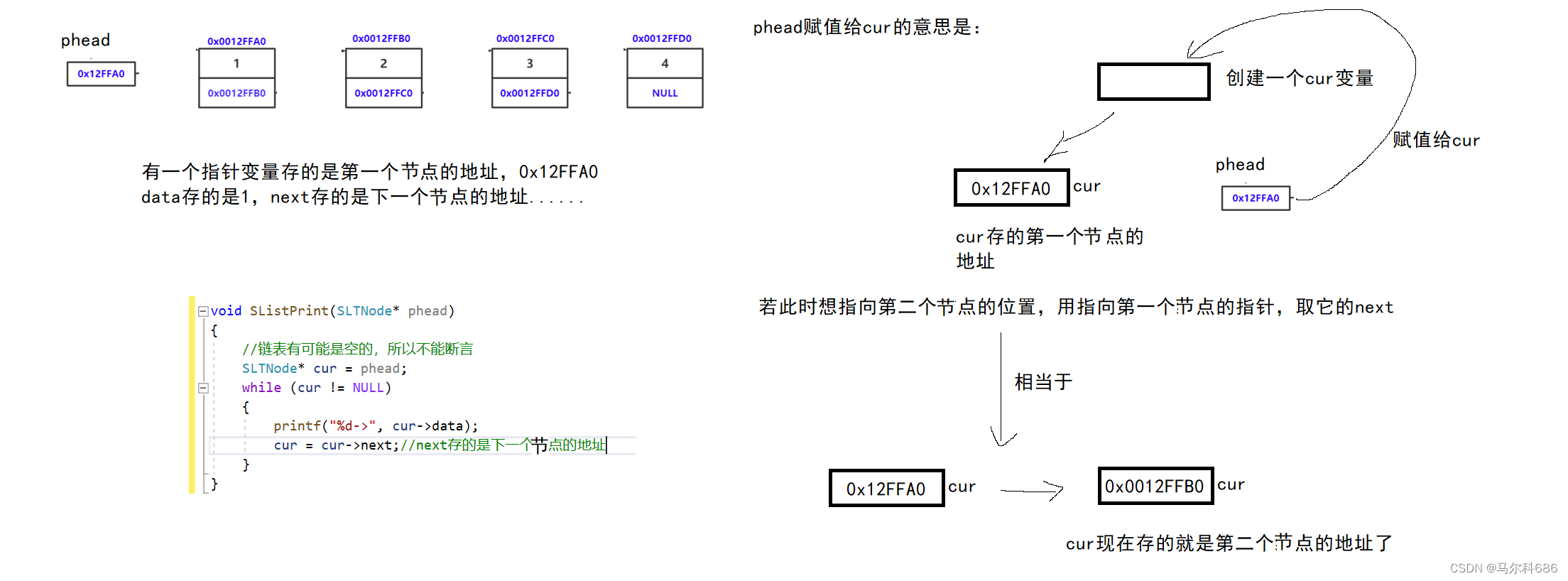
SLTNode* BuySLTNode(SLTDateType x)
{
SLTNode* newnode = (SLTNode*)malloc(sizeof(SLTNode));
if (newnode == NULL)
{
perror("malloc fail");
exit(-1);
}
newnode->data = x;
newnode->next = NULL;
return newnode;
}
错误代码:
void SListPushFront(SLTNode* phead, SLTDateType x)
{
SLTNode* newnode = BuySLTNode(x);
newnode->next = phead;
phead = newnode;
}
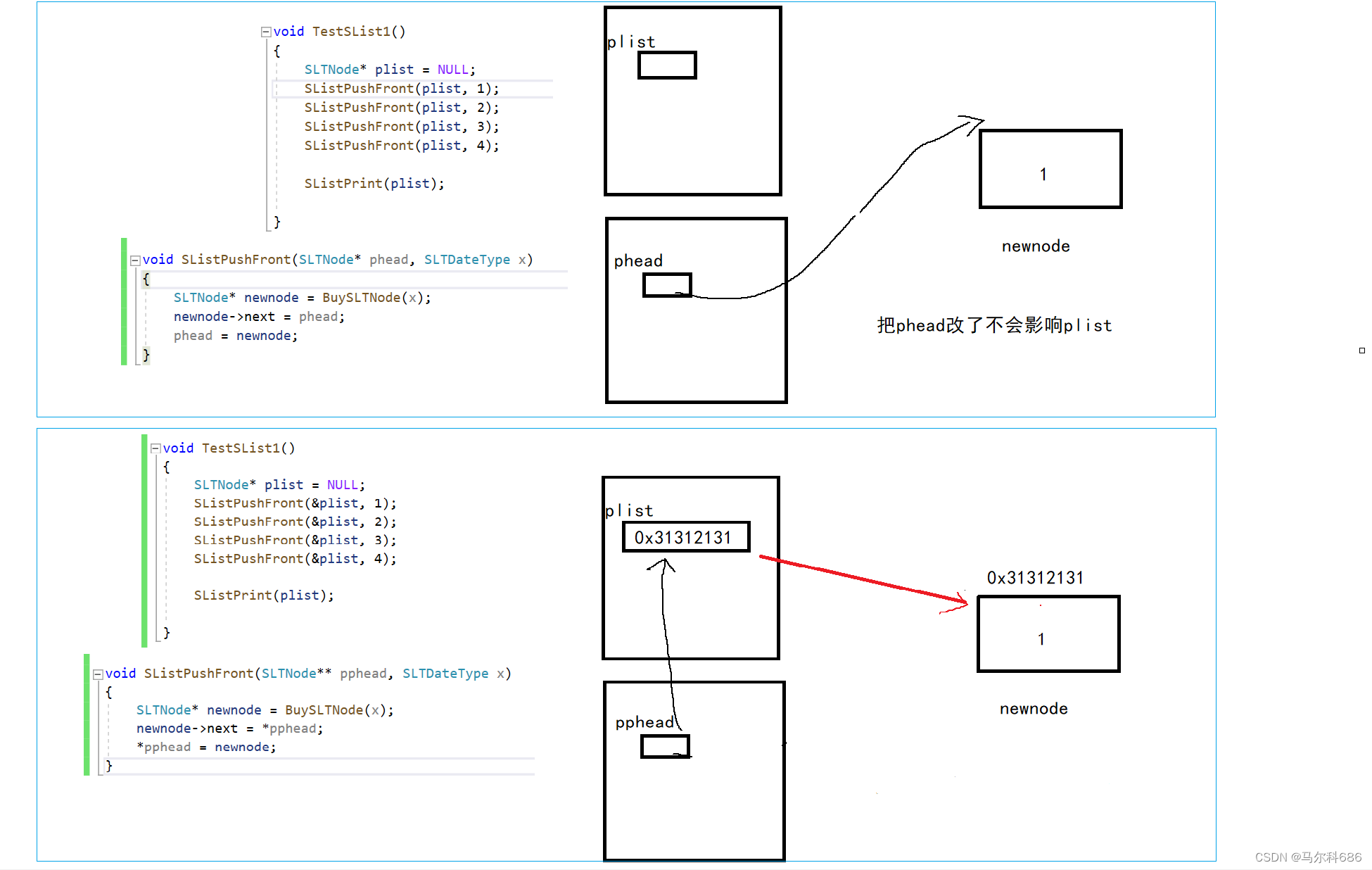
正确代码:
void SListPushFront(SLTNode** pphead, SLTDateType x)
{
assert(pphead);
SLTNode* newnode = BuySLTNode(x);
newnode->next = *pphead;
*pphead = newnode;
}
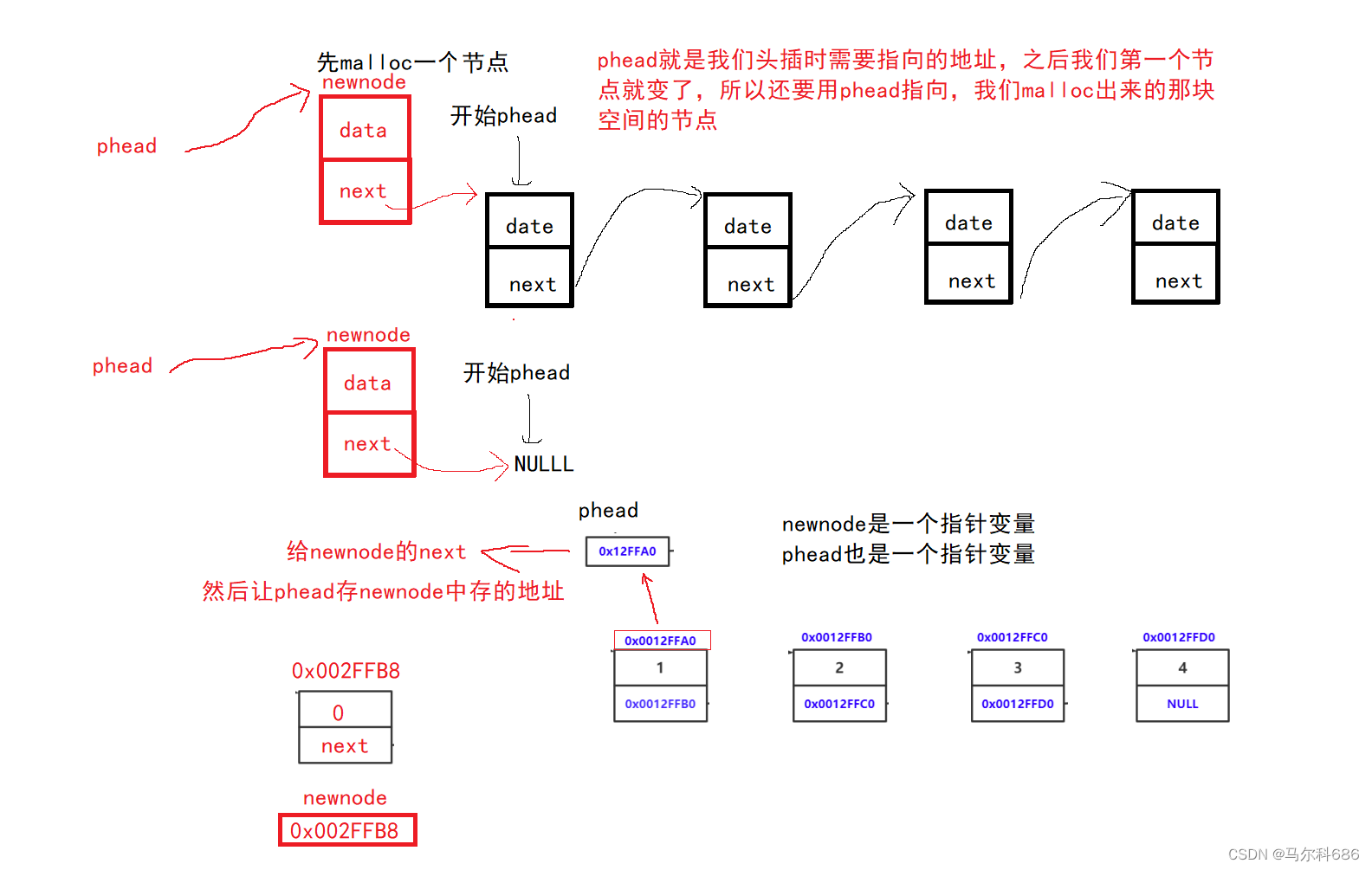
void SListPushBack(SLTNode** pphead, SLTDateType x)
{
assert(pphead);
SLTNode* newnode = BuySLTNode(x);
if (*pphead == NULL)
{
*pphead = newnode;
}
else
{
//找尾
SLTNode* tail = *pphead;
while (tail->next != NULL)
{
tail = tail->next;
}
tail->next = newnode;
}
}
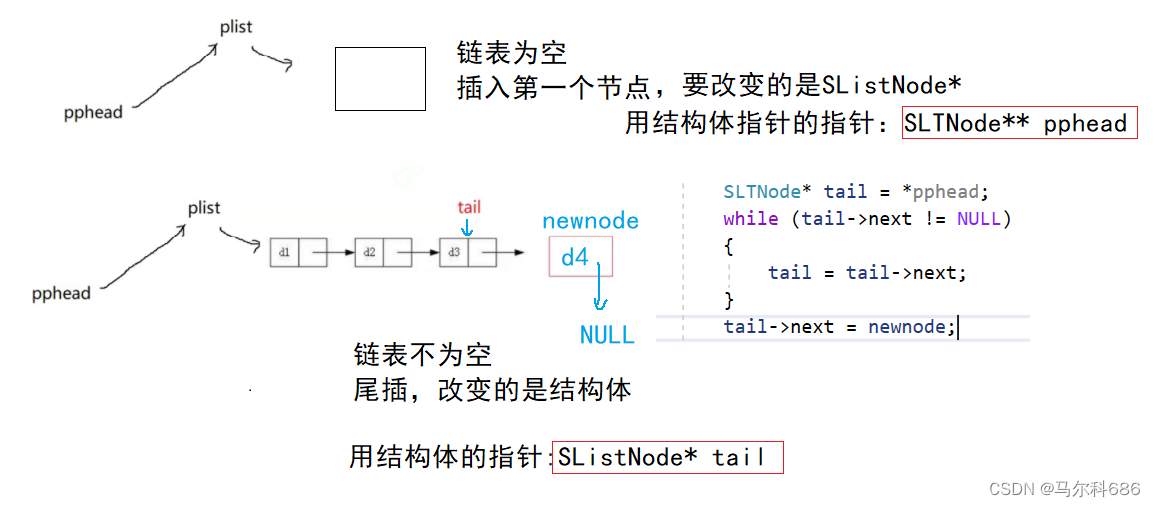
void SListPopFront(SLTNode** pphead)
{
assert(pphead);
//温柔的检查
/*if (*pphead == NULL)
{
return;
}*/
//暴力检查
assert(*pphead != NULL);
SLTNode* del = *pphead;
*pphead = (*pphead)->next;
free(del);
del = NULL;
}
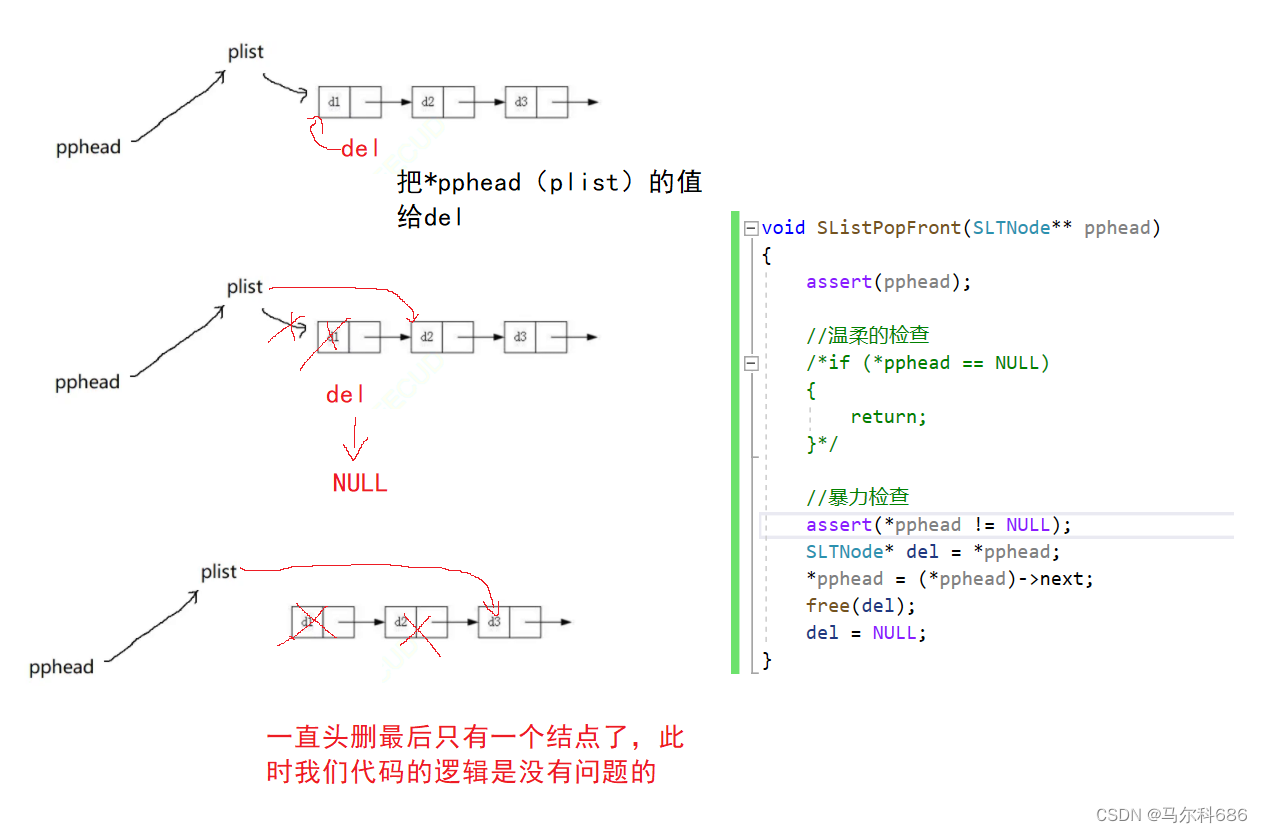
双指针:
void SListPopBack(SLTNode** pphead)
{
assert(pphead);
//温柔的检查
/*if (*pphead == NULL)
{
return;
}*/
//暴力检查
assert(*pphead != NULL);
if ((*pphead)->next == NULL)
{
free(*pphead);
*pphead = NULL;
}
else
{
//找尾
SLTNode* prev = NULL;
SLTNode* tail = *pphead;
while (tail->next != NULL)
{
prev = tail;
tail = tail->next;
}
prev->next = NULL;
free(tail);
tail = NULL;
}
}
第二种方法:
void SListPopBack2(SLTNode** pphead)
{
assert(pphead);
//温柔的检查
/*if (*pphead == NULL)
{
return;
}*/
//暴力检查
assert(*pphead != NULL);
if ((*pphead)->next == NULL)
{
free(*pphead);
*pphead = NULL;
}
else
{
//找尾
SLTNode* tail = *pphead;
while (tail->next->next != NULL)
{
tail = tail->next;
}
free(tail->next);
tail->next = NULL;
}
}
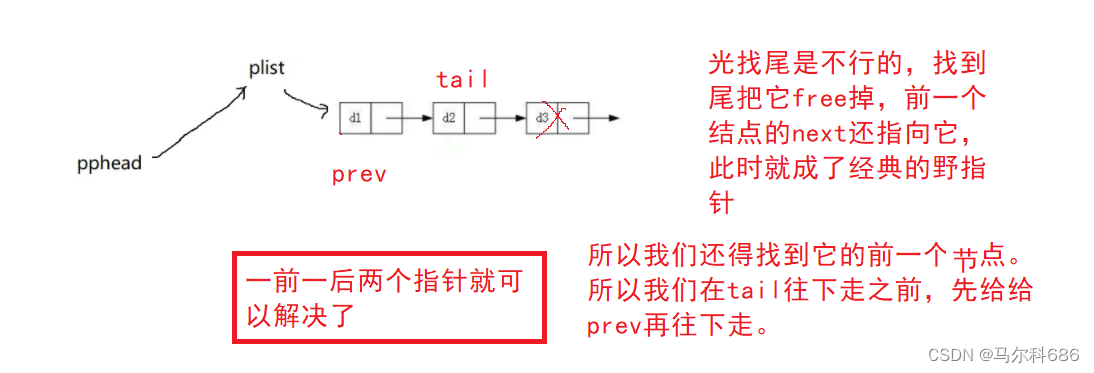
void SListDestory(SLTNode** pphead)
{
assert(pphead);
SLTNode* cur = *pphead;
while (cur != NULL)
{
SLTNode* next = cur->next;
free(cur);
cur = next;
}
*pphead = NULL;
}
SLTNode* SListFind(SLTNode* phead, SLTDateType x)
{
SLTNode* cur = phead;
while (cur != NULL)
{
if (cur->data == x)
{
return cur;
}
cur = cur->next;
}
return NULL;
}
一般找到后直接就修改了
void TestSList3()
{
SLTNode* plist = NULL;
SListPushBack(&plist, 1);
SListPushBack(&plist, 2);
SListPushBack(&plist, 3);
SListPushBack(&plist, 4);
SListPrint(plist);
SLTNode* pos = SListFind(plist, 3);
if (pos)
{
//修改
pos->data *= 10;
printf("找到啦\n");
}
else
{
printf("没找到\n");
}
SListPrint(plist);
SListDestory(plist);
}
int main()
{
TestSList3();
return 0;
}
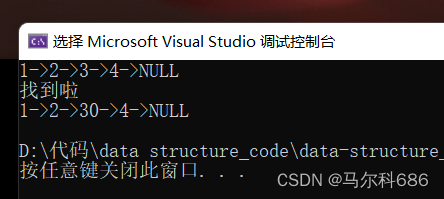
//在pos之前插入
void SListInsert(SLTNode** pphead,SLTNode* pos, SLTDateType x)
{
assert(pphead);
assert(pos);
if (pos == *pphead)
{
SListPushFront(pphead, x);
}
else
{
SLTNode* prev = *pphead;
while (prev->next != pos)
{
prev = prev->next;
//暴力检查,pos不在链表中
assert(prev);
}
SLTNode* newnode = BuySLTNode(x);
prev->next = newnode;
newnode->next = pos;
}
}
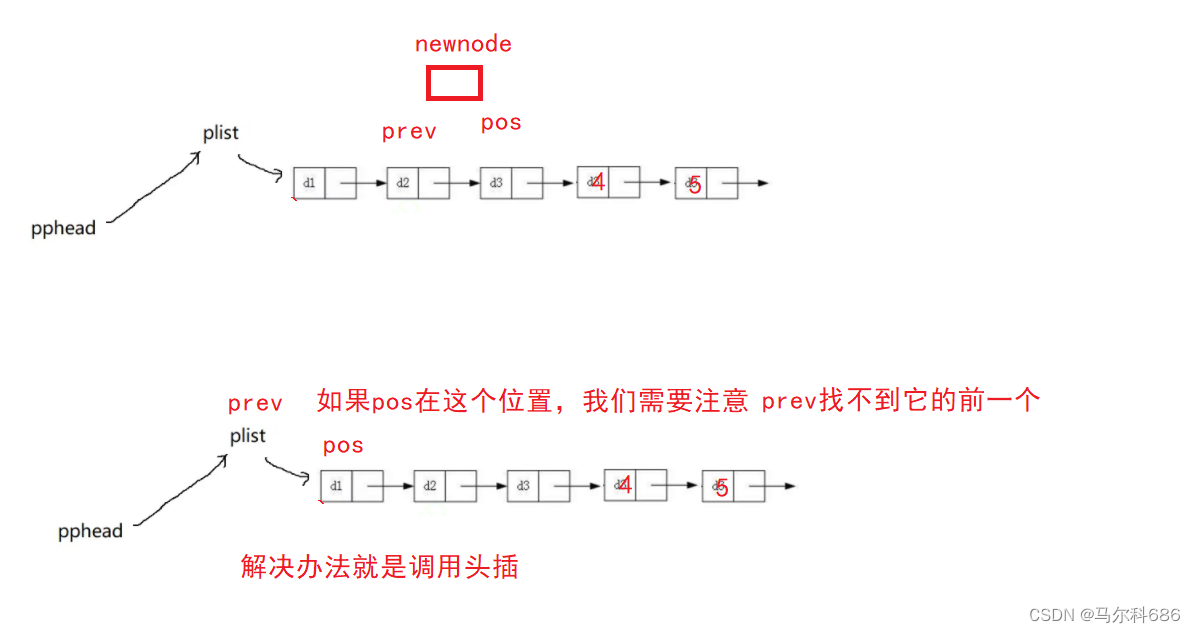
void SListInsertAfter(SLTNode* pos, SLTDateType x)
{
assert(pos);
SLTNode* newnode = BuySLTNode(x);
newnode->next = pos->next;
pos->next = newnode;
}
SList.h
#pragma once
#include <stdio.h>
#include<assert.h>
#include<stdlib.h>
typedef int SLTDateType;
typedef struct SListNode
{
SLTDateType data;
struct SListNode* next;
}SLTNode;
//创建malloc结点的指针
SLTNode* BuySLTNode(SLTDateType x);
//链表打印
void SListPrint(SLTNode* phead);
//链表销毁
void SListDestory(SLTNode* phead);
//链表的头部插入
void SListPushFront(SLTNode** pphead, SLTDateType x);
//尾插
void SListPushBack(SLTNode** pphead, SLTDateType x);
//尾删
void SListPopBack(SLTNode** pphead);
//头删
void SListPopFront(SLTNode** pphead);
//链表的查找
SLTNode* SListFind(SLTNode* phead,SLTDateType x);
//某个位置去插入 ---- 在pos之前插入
void SListInsert(SLTNode** pphead, SLTNode* pos, SLTDateType x);
//在pos之后插入
void SListInsertAfter(SLTNode* pos, SLTDateType x);
SList.c
#include"SList.h"
void SListPrint(SLTNode* phead)
{
//链表有可能是空的,所以不能断言
SLTNode* cur = phead;
while (cur != NULL)
{
printf("%d->", cur->data);
cur = cur->next;//next存的是下一个结点的地址
}
printf("NULL\n");
}
SLTNode* BuySLTNode(SLTDateType x)
{
SLTNode* newnode = (SLTNode*)malloc(sizeof(SLTNode));
if (newnode == NULL)
{
perror("malloc fail");
exit(-1);
}
newnode->data = x;
newnode->next = NULL;
return newnode;
}
void SListPushFront(SLTNode** pphead, SLTDateType x)
{
assert(pphead);
SLTNode* newnode = BuySLTNode(x);
newnode->next = *pphead;
*pphead = newnode;
}
void SListPushBack(SLTNode** pphead, SLTDateType x)
{
assert(pphead);
SLTNode* newnode = BuySLTNode(x);
if (*pphead == NULL)
{
*pphead = newnode;
}
else
{
//找尾
SLTNode* tail = *pphead;
while (tail->next != NULL)
{
tail = tail->next;
}
tail->next = newnode;
}
}
void SListPopFront(SLTNode** pphead)
{
assert(pphead);
//温柔的检查
/*if (*pphead == NULL)
{
return;
}*/
//暴力检查
assert(*pphead != NULL);
SLTNode* del = *pphead;
*pphead = (*pphead)->next;
free(del);
del = NULL;
}
void SListPopBack(SLTNode** pphead)
{
assert(pphead);
//温柔的检查
/*if (*pphead == NULL)
{
return;
}*/
//暴力检查
assert(*pphead != NULL);
if ((*pphead)->next == NULL)
{
free(*pphead);
*pphead = NULL;
}
else
{
//找尾
SLTNode* prev = NULL;
SLTNode* tail = *pphead;
while (tail->next != NULL)
{
prev = tail;
tail = tail->next;
}
prev->next = NULL;
free(tail);
tail = NULL;
}
}
void SListPopBack2(SLTNode** pphead)
{
assert(pphead);
//温柔的检查
/*if (*pphead == NULL)
{
return;
}*/
//暴力检查
assert(*pphead != NULL);
if ((*pphead)->next == NULL)
{
free(*pphead);
*pphead = NULL;
}
else
{
//找尾
SLTNode* tail = *pphead;
while (tail->next->next != NULL)
{
tail = tail->next;
}
free(tail->next);
tail->next = NULL;
}
}
void SListDestory(SLTNode** pphead)
{
assert(pphead);
SLTNode* cur = *pphead;
while (cur != NULL)
{
SLTNode* next = cur->next;
free(cur);
cur = next;
}
*pphead = NULL;
}
SLTNode* SListFind(SLTNode* phead, SLTDateType x)
{
SLTNode* cur = phead;
while (cur != NULL)
{
if (cur->data == x)
{
return cur;
}
cur = cur->next;
}
return NULL;
}
//在pos之前插入
void SListInsert(SLTNode** pphead,SLTNode* pos, SLTDateType x)
{
assert(pphead);
assert(pos);
if (pos == *pphead)
{
SListPushFront(pphead, x);
}
else
{
SLTNode* prev = *pphead;
while (prev->next != pos)
{
prev = prev->next;
//暴力检查,pos不在链表中
assert(prev);
}
SLTNode* newnode = BuySLTNode(x);
prev->next = newnode;
newnode->next = pos;
}
}
void SListInsertAfter(SLTNode* pos, SLTDateType x)
{
assert(pos);
SLTNode* newnode = BuySLTNode(x);
newnode->next = pos->next;
pos->next = newnode;
}
test.c
#include"SList.h"
void TestSList1()
{
SLTNode* plist = NULL;
SListPushFront(&plist, 1);
SListPushFront(&plist, 2);
SListPushFront(&plist, 3);
SListPushFront(&plist, 4);
SListPrint(plist);
SListPopFront(&plist);
SListPrint(plist);
SListPopFront(&plist);
SListPrint(plist);
SListPopFront(&plist);
SListPrint(plist);
SListPopFront(&plist);
SListPrint(plist);
/*SListPopFront(&plist);
SListPrint(plist);*/
}
void TestSList2()
{
SLTNode* plist = NULL;
SListPushBack(&plist, 1);
SListPushBack(&plist, 2);
SListPushBack(&plist, 3);
SListPushBack(&plist, 4);
SListPrint(plist);
SListPopBack(&plist);
SListPrint(plist);
SListPopBack(&plist);
SListPrint(plist);
SListPopBack(&plist);
SListPrint(plist);
SListPopBack(&plist);
SListPrint(plist);
/*SListPopBack(&plist);
SListPrint(plist);*/
}
void TestSList3()
{
SLTNode* plist = NULL;
SListPushBack(&plist, 1);
SListPushBack(&plist, 2);
SListPushBack(&plist, 3);
SListPushBack(&plist, 4);
SListPrint(plist);
SLTNode* pos = SListFind(plist, 3);
if (pos)
{
//修改
pos->data *= 10;
printf("找到啦\n");
}
else
{
printf("没找到\n");
}
SListPrint(plist);
pos = SListFind(plist, 1);
if (pos)
{
SListInsert(&plist, pos, 20);
}
SListPrint(plist);
SListDestory(plist);
}
int main()
{
//TestSList1();
//TestSList2();
TestSList3();
return 0;
}